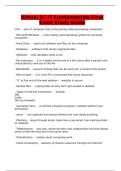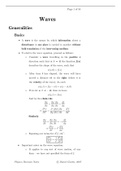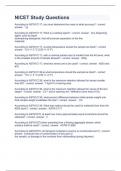Institutional and Substantive EU Law - Lecture Notes
13.09.2021
Lecture 1
Schuman Declaration (1950)
- Coming together of nations of EU → requires elimination of age-old opposition
France v Germany
- Schuman: EU organization, goals and aims to achieve
- If France and Germany agree→ something happens in EU
- Preposition: Franco German production of coal and steel as a whole placed under
High Authority → participation to make Europe
- Luxemburg: big steel industry (strategic position) - needed to get it onboard
- Institutional structure→ Scheme composed by independent people (Commission)
appointed by gov
- Chairman chosen by common agreement between
governments (Council)
- Authority decisions enforceable in France/Germany
(Supranational) → losing sovereignty
- EU Parliament→ Schuman no democratic measure
because: leads to federal states
- Respectful constitutional design
- Two takeaways from Schuman→ 1. The constitutional design is recognizable
- Recognizable already 1950
2. EU more than economics
- Solidarity between people
- Ex: Poland/Hungary
- Rule of law
- Preamble of 1957 Treaty of Rome → resulting in EEC
- Determined the foundations of EU
- “Ever closer union” unknown meaning
5 Questions
1. Who is doing what
- Actors, Principal (commission, council), Agent
2. What
- Partial integration
3. Where
4. Why
- Peace, security ecc
5. How
- Cooperation
Challenges of European Integration
, 1. States must learn to cooperate
→ ex: Catalonia, Scotland independence
2. Citizens as well
3. Ease interactions between individuals in society not only between states
4. Different national modes of thinking meet
5. Compulsory substantive cooperation in the field of law, politics, economy
6. Different political opinions → reach agreement
→ Brexit success: UK did not like EU continental law
Benchmarks/Choices
1. Peace of Westphalia
- 30 years war
- Agreement→ Mutual recognition of borders
- Principle of non-intervention in other states
- Recognition of sovereignty
- Creates concept→ failed state ex: Somalia (no one wants to enter)
- State authority executes until that border
2. Schuman Declaration
- Political choice of cooperation
- Want to fade away borders
- Far-reaching cooperation between states and transfer of sovereign powers of
states to other entities
- Successful→ since 1950
Copenhagen Criteria (1993)- EU Council
- Before East enlargement (only 12 MS)
- Membership criteria
1. Stability of institutions guaranteeing democracy/ rule of law/ human rights/
protection of minorities
2. Functioning market economy to cope w competitive pressure and market
forces w Union
3. Obligations of membership→ adherence to aimes of political, economic,
monetary union
- First Document→ EU Council + Presidents MS: verbalized what they wanted to be
- First definition of EU corporate identity
Rule of Law
Individuals not above law / way to organize society
→ Umbrella for human rights + democracy
- Form part of system
- By UK→ guarantee trade and commerce
→ protection of intellectual rights
→ safety of economic trade
, Requirements to compare Copenhagen criteria
1. Principle of legality
- Need laws
- Predictability→ peaceful society
2. Division of power
- Montesquieu → Trias Politica
- Split execution of powers, not only one sovereign
- Different authorities
3. Fundamental (human) rights
- Rule of law = human rights
- 1. Can't be convicted if you didn’t know you couldn’t do it
4. Judicial review
- System closed interpretation and execution of rules
- Division of powers→ someone takes decision (judges)
1st requirement- Principle of Legality
- Core of rule of law
- Traced back to constitutions of European treaties
- 3 functions attributed to law → 1. Norm setting
- Art. 30 TFEU : customs duties
2. Executive order for administration being a right
or duty
- Executive is predictable
3. Tie for executive and safeguard for citizens
- Power conferral from MS→ EU
- Art 3 TEU: Sets purpose of EU
- Art 3-6: policy fiends and competences of EU
- Art 119: connects economic activities to MS-Union
- Art 5: limits competences by principle of conferral
2nd requirement- pt.1 Vertical Division of Powers
- Kind of states: Centralised Unitary State
Decentralised Unitary State - ex: France
Federal State - Regulates also for citizens ex: Germany / EU
Commonwealth of States/Confederate States - ex Dutch Republic of
17c
EU: contained by MS
Conferral of competences: Art. 5 TEU
- Foreign policy→ not part of competences
- Art 3 TFEU: exclusive competence for foreign trade EU
Pt.2 Distribution of Horizontal Powers
- Trias Politica→ separation of powers
13.09.2021
Lecture 1
Schuman Declaration (1950)
- Coming together of nations of EU → requires elimination of age-old opposition
France v Germany
- Schuman: EU organization, goals and aims to achieve
- If France and Germany agree→ something happens in EU
- Preposition: Franco German production of coal and steel as a whole placed under
High Authority → participation to make Europe
- Luxemburg: big steel industry (strategic position) - needed to get it onboard
- Institutional structure→ Scheme composed by independent people (Commission)
appointed by gov
- Chairman chosen by common agreement between
governments (Council)
- Authority decisions enforceable in France/Germany
(Supranational) → losing sovereignty
- EU Parliament→ Schuman no democratic measure
because: leads to federal states
- Respectful constitutional design
- Two takeaways from Schuman→ 1. The constitutional design is recognizable
- Recognizable already 1950
2. EU more than economics
- Solidarity between people
- Ex: Poland/Hungary
- Rule of law
- Preamble of 1957 Treaty of Rome → resulting in EEC
- Determined the foundations of EU
- “Ever closer union” unknown meaning
5 Questions
1. Who is doing what
- Actors, Principal (commission, council), Agent
2. What
- Partial integration
3. Where
4. Why
- Peace, security ecc
5. How
- Cooperation
Challenges of European Integration
, 1. States must learn to cooperate
→ ex: Catalonia, Scotland independence
2. Citizens as well
3. Ease interactions between individuals in society not only between states
4. Different national modes of thinking meet
5. Compulsory substantive cooperation in the field of law, politics, economy
6. Different political opinions → reach agreement
→ Brexit success: UK did not like EU continental law
Benchmarks/Choices
1. Peace of Westphalia
- 30 years war
- Agreement→ Mutual recognition of borders
- Principle of non-intervention in other states
- Recognition of sovereignty
- Creates concept→ failed state ex: Somalia (no one wants to enter)
- State authority executes until that border
2. Schuman Declaration
- Political choice of cooperation
- Want to fade away borders
- Far-reaching cooperation between states and transfer of sovereign powers of
states to other entities
- Successful→ since 1950
Copenhagen Criteria (1993)- EU Council
- Before East enlargement (only 12 MS)
- Membership criteria
1. Stability of institutions guaranteeing democracy/ rule of law/ human rights/
protection of minorities
2. Functioning market economy to cope w competitive pressure and market
forces w Union
3. Obligations of membership→ adherence to aimes of political, economic,
monetary union
- First Document→ EU Council + Presidents MS: verbalized what they wanted to be
- First definition of EU corporate identity
Rule of Law
Individuals not above law / way to organize society
→ Umbrella for human rights + democracy
- Form part of system
- By UK→ guarantee trade and commerce
→ protection of intellectual rights
→ safety of economic trade
, Requirements to compare Copenhagen criteria
1. Principle of legality
- Need laws
- Predictability→ peaceful society
2. Division of power
- Montesquieu → Trias Politica
- Split execution of powers, not only one sovereign
- Different authorities
3. Fundamental (human) rights
- Rule of law = human rights
- 1. Can't be convicted if you didn’t know you couldn’t do it
4. Judicial review
- System closed interpretation and execution of rules
- Division of powers→ someone takes decision (judges)
1st requirement- Principle of Legality
- Core of rule of law
- Traced back to constitutions of European treaties
- 3 functions attributed to law → 1. Norm setting
- Art. 30 TFEU : customs duties
2. Executive order for administration being a right
or duty
- Executive is predictable
3. Tie for executive and safeguard for citizens
- Power conferral from MS→ EU
- Art 3 TEU: Sets purpose of EU
- Art 3-6: policy fiends and competences of EU
- Art 119: connects economic activities to MS-Union
- Art 5: limits competences by principle of conferral
2nd requirement- pt.1 Vertical Division of Powers
- Kind of states: Centralised Unitary State
Decentralised Unitary State - ex: France
Federal State - Regulates also for citizens ex: Germany / EU
Commonwealth of States/Confederate States - ex Dutch Republic of
17c
EU: contained by MS
Conferral of competences: Art. 5 TEU
- Foreign policy→ not part of competences
- Art 3 TFEU: exclusive competence for foreign trade EU
Pt.2 Distribution of Horizontal Powers
- Trias Politica→ separation of powers










